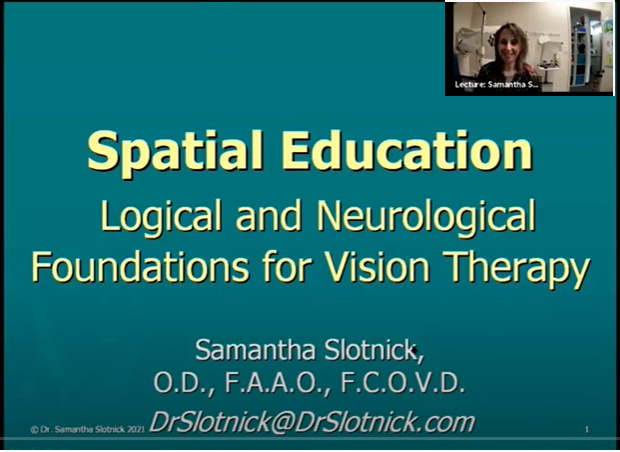Access to 3-hour COPE-approved webinar, presented as part of the Eastern States Optometric Congress on 11/14/2021.
Course presents neurologically-substantiated vision therapy activities, with broad applicability among binocular and oculomotor dysfunctions. These activities help establish foundational spatial relationships within the patient’s body and as a framework for interacting with one’s spatial surroundings.
Goals of the Course:
- Explore therapy activities which help the patient integrate visual-spatial processing skills with visual-motor consistency across environment, body and binocular oculomotor posture.
- Provide a logical and neurological foundation for these activities, which will resonate with doctors, therapists and their patients.
This course presents vision therapy activities which help patients construct foundational spatial relationships. The particular value of these activities became apparent in strabismus rehabilitation, as these patients tend to trust logic and deduction above their visual input. These foundational activities are just as valuable for patients with binocular dysfunctions, oculomotor control challenges, and acquired brain injury. In addition, they can be explored and revisited at any point during a rehabilitation process, as they continue to yield learning opportunities over a wide strata of functional abilities.
This course presents vision therapy activities which help patients construct foundational relationships:
- Between the body and gravity
- Between each eye and each hand
- Between eye movements and body movements
- Between the body and the spatial frame of the room
In addition, activities are presented which heighten the potential for binocular alignment by priming the muscles responsible for sustained fine-tuning of eye posture and by providing binocular biofeedback during multi-sensory integration activities.
Collectively, these elegant procedures provide novel opportunities for patients to develop neurological organization within the body, and to plan accurate visually-guided movement within a stable space.
Outline:
- Putting logic to good use:
- Activities which provide opportunities to develop both ipsi- and contralateral eye-hand control
- Spatial framing:
- Activities which elevate awareness to one’s spatial frame of reference in (x,y,z) dimensions
- Accessing our Sixth Sense:
- Spatial activities which develop visual-vestibular integration
- Fine-tuning our 24 Extraocular Muscles:
- Neurologically-based activities which enhance oculomotor control
- Cheaters never win:
- Activities which provide true binocular biofeedback (MFBF) during multi-sensory integration, rather than enabling sectoral alternation



Your cart is empty


Recent Comments